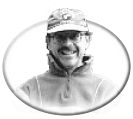
Mooching For Salmon
with
D.C. Reid
illustrations by Barb Krimmer
Mooching for salmon combines the best natural lure - cut plug or whole anchovy or herring - with the best in boating: lazing around in your shorts on a sunny afternoon. Bring your shades, your book and drift with the tide while seabirds call-out the herring balls.
Usually performed in back eddies, mooching comes into its own as a productive fishing technique where fish congregate in large numbers in relatively small spaces. Obvious spots to consider include back eddies behind islands, passes, reefs and kelp beds, in fact, any location where land features choke tidal flow, restricting the amount of physical space in which fish can spread out.
Along with current- and land- defined "pools", other high-percentage mooching possibilities have to include spots where bait fish school in large numbers. Tide lines, whether or not close to land, bunch bait fish stocks. Herringballs, the location of which are determined by frenetic seagull activity, can be seen for miles. These balls of living flesh almost inevitably spell the presence of salmon. Successful fall afternoons result from fishers slowly following herring activity around the fishing grounds.
At other times, look for bait at night in front of lighted docks and where dimples spot the surface at the crack of dawn. During the late winter months of February and March, areas where spawning herring gather to ripen become salmon magnets, drawing resident
chinook
salmon for miles around.
Specific mooching gear should be assembled. Long limber 9- to 10 ½- foot fishing rods combine with single-action graphite fishing reels and at least 300 yards of 25 pound test monofilament line. The long rods perform two duties: separating the dangling baits and signifying the "pop up"; the most common bite in mooching occurs moments after the tippy tip of the mooching rod lifts slightly. A time of high excitement and adrenaline for the fisher, in this brief period, the salmon, usually a chinook or
coho
, takes the bait in its mouth and ascends in the water, lifting the 1- to 6- oz banana weight ever so fractionally. This telegraphs instantaneously to the rod, hence the need for a long sensitive tip.
At the tackle end, the mooching setup is completed with a banana weight, one of the simplest most elegant pieces of fishing gear sold. Tied to the weight, 6 feet of 15- to 20- pound leader descends to the bait rig. And at the business end, mooching is a sport for bait: whole herring or anchovy, either dead or alive, cut plug herring or anchovy or herring strip.
Mooching is the only fishing technique that reaches its peak in slow motion. The bait sways lazily beneath a stationary or drifting boat. Live bait struggles vainly to escape, sending off vibrations recognized by a salmon's lateral line and internal ear or otoliths as wounded prey. Alternatively, a cut plug may be slowly trolled by putting the boat into gear and then taking it out.
Because mooching affords the salmon a good long look at the bait, subterfuge proves necessary. Hence the lighter than usual leader. Hence a smaller than usual hook size. In trebles it is not uncommon to use the 4 to 6 size range; in singles, the 1/0 to 3/0.
Cut plugging remains the most difficult technique to master. A sharp knife first lays right behind the gills of a semi-frozen bait fish from dorsal to ventral surface. Then the knife blade rotates to establish two angles in the bait: a 45 degree toward the tail end and, as well, a 45 degree angle toward the lateral flank that rests on the cutting board. In one clean slice, the head is cut off. If the operation has been performed correctly, the bevelled face causes the cut plug to spiral in the water; if not, it renders the bait useless, IE., it won't catch fish. The knife then twirls the entrails from the body cavity, leaving the opening skin intact. Precision is the key.

Hook placement is an art form, and the fisher spends many years perfecting this aspect of cutplug fishing. The trailing hook inserts through the trailing flank first. Second, the leading hook inserts through the meaty side of the cut plug in an upward direction. The barb follows, passing through the dorsal surface on that side, too. Finally, the trailing hook passes over the bait, inserts in the lateral line behind the dorsal fin and the shank buries in the flesh. (See diagram for details).
Bait, both for whole or cut plug mooching, should be stiffened beforehand. A simple solution of ½ pound pickling salt to 1 quart water hardens bait for easy handling. A tackle box-size jar also keeps bait fresh for up to three weeks in the fridge.
Finally, the fisher prepares him or herself for fishing. Bait descends to the fishy depth, in summer usually 0 to 50 feet deep, and in winter, 75 to 100 feet. Remember one small tip, if bait rigs and main lines keep returning to the boat tangled, attach a 1 oz rubber core weight on the main line two feet up from the banana weight.
Now all there is to do is lean back contemplating the wonders of the universe under the soft yellow rays of summer sun. The quiet of the B.C. coast takes over; the glassy green cool sea filled with voracious chinook and coho; the arbutus draped like actresses in smoky movies. And then, barely perceptible, the rod tip lifts up.
|




